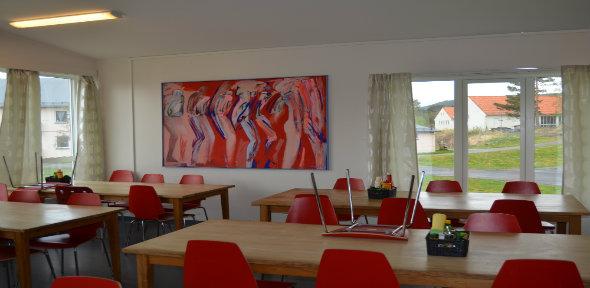
Condiments and comparisons
Many prisons in Norway have communal dining areas, in a way that relatively few prisons do in England & Wales. We were in one of these dining areas recently, in Bjørgvin prison, on the West coast of Norway, giving out surveys to a small group of prisoners. As they set about the task of filling these in for around twenty minutes (to help us assess the nature of their prison experience, and compare it to prisons in England & Wales), we sat around (on red Ikea chairs), answered some questions, looked out of the windows at the mountains that framed the prison, and gazed around the room.
The details of the room are worthy of comment because of what they signify about Norwegian imprisonment. Sitting on top of one surface was a bowl of apples; on another was a row of containers holding savoury biscuits and cereals. On each table, there was a square basket holding condiments including tomato ketchup, mayonnaise, lemon juice and Nutella, in large plastic bottles. Prisoners had also brought into the room a large heated flask of coffee, to which we all helped ourselves casually throughout the research exercise, adding milk from the kind of dispenser found on a hotel breakfast sideboard. On the wall was a large clock and a red, abstract painting. All of these features gave the room the feel of a youth hostel or a student hall of residence.
None of the Norwegian prisoners considered these objects to be anything other than banal, but as an outsider they were striking in the way that they reflected a very different kind of relationship between prisoners and the institution: the prison trusted prisoners not to simply take everything that had been left out for public consumption, and prisoners seemed to have no interest in doing so. It is really quite difficult to know whether this could work in a prison in England & Wales, beyond a handful of small, special units. Commentators on penal issues often look to the Nordic countries, and ask why we don’t just import their practices, and generally I share this perspective. But whether the norms of our prisons, shaped as they are by wider social and penal sensibilities, would make such practices possible, even if they were deemed to be acceptable, is hard to gauge. Perhaps the apples would be taken, and used to make hooch; perhaps the Nutella would end up as a commodity in the illicit prisoner economy. Perhaps graffiti would appear on the abstract painting, as a statement against the authority of the institution.
Here also lies one of the complexities of comparative research. In discussing their quality of life, Norwegian prisoners did not mention these items, either as material goods in themselves or as indicators of how they, as prisoners, were regarded by the institution, just as they do not notice or mention how much smaller, quieter and more open these institutions are, because they have no comparative benchmark. To us, though, these differences were stark and significant.
Dr Ben Crewe leads the COMPEN team and is Deputy Director of the Prisons Research Centre, Institute of Criminology, University of Cambridge.

 The Comparative Penology Group is led by Dr Ben Crewe and his research team who, since 2016, have been working on a five-year project titled: 'Penal policymaking and the prisoner experience: a comparative analysis'.
The Comparative Penology Group is led by Dr Ben Crewe and his research team who, since 2016, have been working on a five-year project titled: 'Penal policymaking and the prisoner experience: a comparative analysis'.
